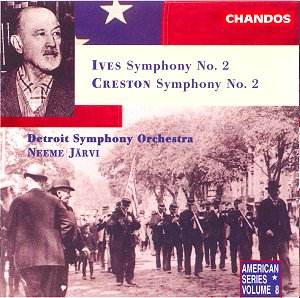CHARLES IVES (1874-1954)
Symphony No. 2 (1897-1901) 34.33
PAUL CRESTON (1906-1985)
Symphony No. 2 (1944) 21.55
 Detroit SO/Neeme Järvi
Detroit SO/Neeme Järvi
rec 29 April 1 May 1995, Detroit
 CHANDOS CHAN 9390 (American
Series vol. 8)
[56.37]
CHANDOS CHAN 9390 (American
Series vol. 8)
[56.37]
Crotchet

Mention of Charles Ives usually sends listeners running for cover. Perhaps
this is because they associate him with the exploratory complexities of the
Fourth Symphony. In fact much of his output is far from belligerently
adventurous. The first two symphonies have much more in common with Dvorak
and Brahms than anything else.
The second symphony is unusual in being in five movements. The first is a
string section-dominated andante. The second holds traces of a jolly march
(recalling the hymn Bringing in the Sheaves) and elements of Bruckner and
Dvorak alongside Mendelssohn (Italian Symphony). A memorably gauche helping
of drum punctuation marks out the centre of the movement and a definite trombone
flourish closes the allegro. The adagio cantabile is sentimental while the
casual 2.15 lento takes us back to the Bach-Reger string choirs of the first
movement. A snatch of Camptown Races here, a splash of Praise meeting
brass band, reveille bugle calls, a helping of Smetana, Bruch (Scottish
Fantasia), Dvorak and Brahms make up the bluff allegro molto vivace ending
on a resounding confident dissonance. That we have the work at all is down
to the work of two pioneers - Lou Harrison and Henry Cowell who reconstructed
it from the composer's pencil sketches.
The Creston Symphony could hardly be more of a contrast. It has just been
recorded as part of the Naxos American Classics series. In my review I omitted
to mention the present disc. The Naxos neatly couples the first three Creston
symphonies. Järvi's approach is one of power and subtlety. The power
of the recording is startling and the soft fluttering explosion of birdsong
and lyric heartbeat in the first movement probes deeply. That soft explosion
echoes a similar passage in David Diamond's contemporaneous fourth symphony.
The big tune is a little rushed to my ears by comparison with the steadier
statement from David Amos on Koch.
This Chandos series foundered when Järvi left Detroit. A pity it did
not continue as there remains a massive field to cover. For now the Chandos
discs remain a beautifully presented treasure not to be forgotten. The two
symphonies are such different works one wonders whether the coupling was
appropriate. This pattern was true for all the Chandos American series. I
keep expecting Chandos to reissue the discs - mixing and matching should
not be difficult and would make an easy winner in the Enchant series.
A recommendable disc showing two contrasting facets of neglected orchestral
Americana.
Rob Barnett

